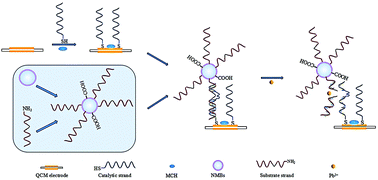Our official English website, www.x-mol.net, welcomes your
feedback! (Note: you will need to create a separate account there.)
QCM-nanomagnetic beads biosensor for lead ion detection
Analyst ( IF 3.6 ) Pub Date : 2017-12-04 00:00:00 , DOI: 10.1039/c7an01498h Qingli Zhang 1, 2, 3, 4 , Haixia Cui 1, 2, 3, 4 , Xingliang Xiong 1, 2, 3, 4 , Jun Chen 2, 3, 4, 5 , Ying Wang 4, 6, 7 , Jia Shen 1, 2, 3, 4 , Yiting Luo 1, 2, 3, 4 , Longcong Chen 1, 2, 3, 4
Analyst ( IF 3.6 ) Pub Date : 2017-12-04 00:00:00 , DOI: 10.1039/c7an01498h Qingli Zhang 1, 2, 3, 4 , Haixia Cui 1, 2, 3, 4 , Xingliang Xiong 1, 2, 3, 4 , Jun Chen 2, 3, 4, 5 , Ying Wang 4, 6, 7 , Jia Shen 1, 2, 3, 4 , Yiting Luo 1, 2, 3, 4 , Longcong Chen 1, 2, 3, 4
Affiliation

|
As lead poses a serious threat to humans even in small amounts, all kinds of lead detection sensors with high sensitivity and selectivity are being constantly improved and put forward. In this report, a novel, simple and label-free quartz crystal microbalance (QCM) biosensor is proposed for detecting lead ions (Pb2+). The biosensor takes full advantage of the high specificity of GR-5 DNAzyme to Pb2+ and the high sensitivity of QCM. In particular, nanomagnetic beads (NMBs) are used as a novel and effective mean of signal amplification in the biosensor because of their mass and their ability to enhance the inductive effect, which are very beneficial for both higher sensitivity and a lower detection limit. In practice, GR-5 DNAzyme, innovatively combined with NMBs, was modified on the gold electrode of the QCM through gold–sulfur self-assembly. When the electrode was exposed to Pb2+ solution, DNAzyme was severed into two parts at the RNA site (rA), along with the release of NMBs, which caused a great increase in frequency shift of the QCM electrode. Finally, a perfect linear correlation between the logarithm of Pb2+ concentration and the change in frequency was obtained from 1 pM to 50 nM, with a detection limit as low as 0.3 pM. Moreover, the biosensor shows both an average recovery of 97 ± 6% in a drinking water sample and an excellent specificity for Pb2+ compared with other metal ions.
中文翻译:

用于铅离子检测的QCM-纳米磁珠生物传感器
由于即使少量也对人类构成严重威胁,因此,具有高灵敏度和高选择性的各种铅检测传感器正在不断改进和提出。在此报告中,提出了一种新颖,简单且无标签的石英晶体微天平(QCM)生物传感器,用于检测铅离子(Pb 2+)。该生物传感器充分利用了GR-5 DNAzyme对Pb 2+的高特异性以及QCM的高灵敏度。特别地,由于纳米磁珠(NMBs)的质量和增强感应效果的能力,它们被用作生物传感器中信号放大的一种新颖而有效的手段,这对于更高的灵敏度和更低的检测极限都是非常有益的。在实践中,通过金硫自组装在QCM的金电极上对GR-5 DNAzyme与NMBs进行了创新结合。当电极暴露于Pb 2+溶液中时,DNA酶在RNA位点(rA)处被切割成两部分,同时NMBs释放出来,这导致QCM电极的频移大大增加。最后,Pb 2+的对数之间具有完美的线性关系浓度和频率变化从1 pM到50 nM,检测限低至0.3 pM。此外,与其他金属离子相比,该生物传感器在饮用水样品中的平均回收率达到97±6%,并且对Pb 2+的特异性极佳。
更新日期:2017-12-04
中文翻译:

用于铅离子检测的QCM-纳米磁珠生物传感器
由于即使少量也对人类构成严重威胁,因此,具有高灵敏度和高选择性的各种铅检测传感器正在不断改进和提出。在此报告中,提出了一种新颖,简单且无标签的石英晶体微天平(QCM)生物传感器,用于检测铅离子(Pb 2+)。该生物传感器充分利用了GR-5 DNAzyme对Pb 2+的高特异性以及QCM的高灵敏度。特别地,由于纳米磁珠(NMBs)的质量和增强感应效果的能力,它们被用作生物传感器中信号放大的一种新颖而有效的手段,这对于更高的灵敏度和更低的检测极限都是非常有益的。在实践中,通过金硫自组装在QCM的金电极上对GR-5 DNAzyme与NMBs进行了创新结合。当电极暴露于Pb 2+溶液中时,DNA酶在RNA位点(rA)处被切割成两部分,同时NMBs释放出来,这导致QCM电极的频移大大增加。最后,Pb 2+的对数之间具有完美的线性关系浓度和频率变化从1 pM到50 nM,检测限低至0.3 pM。此外,与其他金属离子相比,该生物传感器在饮用水样品中的平均回收率达到97±6%,并且对Pb 2+的特异性极佳。










































 京公网安备 11010802027423号
京公网安备 11010802027423号